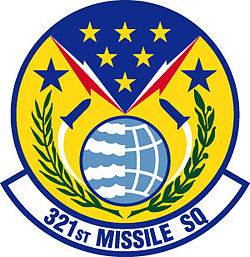| 321st Missile Squadron | |
|---|---|
 LGM-30G Minuteman III test launch at Vandenberg AFB, California | |
| Active | 1942–1946; 1947–1948; 1951–1960; 1964–present |
| Country | |
| Branch | |
| Type | Squadron |
| Role | Intercontinental ballistic missile |
| Part of | Air Force Global Strike Command |
| Garrison/HQ | Francis E. Warren Air Force Base |
| Nickname(s) | Jolly Rogers |
| Motto(s) | 3-2-1...Bombs Away! (World War II) |
| Engagements | Southwest Pacific Theater |
| Decorations | Distinguished Unit Citation Air Force Outstanding Unit Award Philippine Presidential Unit Citation |
| Commanders | |
| Current commander | Lt. Col. David Bull |
| Insignia | |
| 321st Missile Squadron emblem [a] [1] |  |
| Patch with unofficial 321st Strategic Reconnaissance Squadron emblem [2] |  |
| 321st Bombardment Sq emblem [b] [3] |  |
| 321st Bombardment Squadron "Jolly Rogers" patch [c] |  |
The 321st Missile Squadron is a United States Air Force unit. It is assigned to the 90th Operations Group, stationed at Francis E. Warren Air Force Base, Wyoming. The squadron is equipped with the LGM-30G Minuteman III Intercontinental ballistic missile (ICBM). Their mission is to operate safe and secure nuclear weapons, maintain mission ready facilities, and on order destroy OPLAN assigned targets.







